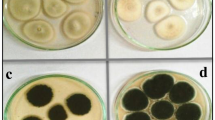Abstract
Extraction of nickel by microbial leaching of Greek laterites is feasible by using ofAspergillus andPenicillium. The effectiveness was found to depend on the ability of the microorganism to produce hydroxycarboxylic acids, especially citric acid, as well as other metabolites. The nickel recoveries achieved were as high as 60%, in 48 d, when the ore was leached in the presence of the living fungi, in a sucrose medium, and as high as 70%, in a much shorter time, when the ore was leached by their metabolic products after pH adjustment by means of sulfuric acid. The use of much cheaper, factory grade, Greek beet molasses as a growth medium proved promising, giving the possibility of making the process more attractive in economic terms.
Similar content being viewed by others
References
Karavaiko G.I., Rossi G., Agate A.D., Groudev S.N., Avkyan Z.Z.:Biogeotechnology of Metals. Manual, UNEP, USSR Commission for UNEF, Centre for International Projects GKNT, Moscow 1988.
King A.B.: The biodegradation of nepheline byAspergillus niger. PhD Thesis. University of London, 1985.
Lundgren D.G., Valcova-Valchanova M., Reed R.: Chemical reactions important in bioleaching and bioaccumulation, in H.L. Ehrlich, D.S. Holmes (Eds):Workshop on Biotechnology for the Mining, Metal-Refining and Fossil Fuel Processing Industries. Biotechnol. Bioeng. Symp. No. 16. John Wiley & Sons, New York 1986.
O'Kane P.T.: Energy consumption and economic trends in the production of nickel from laterites, pp. 503–523 in D.J.I. Evans, R.S. Shoemaker, H. Veltamans (Eds).International Laterite Symposium, Society of Metallurgical Engineers, New York 1979.
Queneau P.E.: Recovery of nickel from its ores.J. Metals 44–48 (1970).
Roorda H.J., Hermans J.M.A.: Energy constraints in the extraction of nickel from oxide ores (i).Erzmetal 34, 82–88 (1981).
Roorda H.J., Hermans J.M.A.: Energy constraints in the extraction of nickel from oxide ores (ii).Erzmetal 34, 186–190 (1981).
Scott T.R.: Recent advances in hydrometallurgy with implications for the developing countries, pp. 56–89 inEconomics of Mineral Engineering (seminar organized by the United Nations in cooperation with the government of Turkey, Ankara 1976.
Shu P., Johnson M.J.: Effect of the composition of the sporulation medium on citric acid production byA. niger in submerged culture.J. Bacteriol. 54, 161–167 (1947).
Shu P., Johnson M.J.: The interdependence of medium constituents in citric acid production by submerged fermentation.J. Bacteriol. 56, 577–585 (1948).
Tzeferis P.G.: Bioleaching of non-sulphide nickeliferous ores using heterotrophic microorganisms.PhD Thesis. National Technical University of Athens 1991.
Tzeferis P.G., Agatzini S.: Leaching of nickel and iron from non-sulphide Greek nickeliferous ores by organic acids.Hydrometallurgy, in press (1994).
Author information
Authors and Affiliations
Rights and permissions
About this article
Cite this article
Tzeferis, P.G. Fungal leaching of nickeliferous laterites. Folia Microbiol 39, 137–140 (1994). https://doi.org/10.1007/BF02906809
Received:
Revised:
Issue Date:
DOI: https://doi.org/10.1007/BF02906809




